Most people are familiar, at least in passing, with the rules of the Big Five sports: football, baseball, basketball, hockey, and soccer. Lacrosse rules may be a bit less familiar. But lacrosse is one of the fastest-growing sports in the country. That means it’s a great time to learn the rules of the game. So if you or your young athlete are looking to play lacrosse, don’t let the rulebook daunt you. We’ve got your back!
Table of Contents
The Basic Lacrosse Rules
Equipment rules
According to the basic rules of lacrosse, each player must have a lacrosse stick, gloves, a helmet, shoulder pads, arm or elbow pads, cleats or turf shoes, shorts, a jersey, a mouth guard, and a cup to play in a game.
There are two types of lacrosse stick: short stick and long stick. A long stick or “long pole” is used mainly on defense to help prevent the opponent from scoring. It enables defensive players to have a longer reach. This makes it easier to execute an effective “stick check” to dislodge the ball from the stick of an opposing player. A lacrosse goalie stick can be short stick length or long stick length, depending on personal preference. The main difference is the “head” on the goalie stick, which is much larger than those of the other lacrosse sticks.
Lacrosse game clock rules
A lacrosse game is split up into four quarters: eight minutes each at the youth level, twelve minutes for high school lacrosse, and fifteen minutes for college and pro. There is a brief 2-minute break in between quarters and a longer 10-minute break at halftime. Each team is given two timeouts per half and teams alternate which half of the field they will occupy/defend after every quarter. If the game ends in a tie, overtime is a 4-miute-long period of sudden-death, where the first team to score a goal wins.
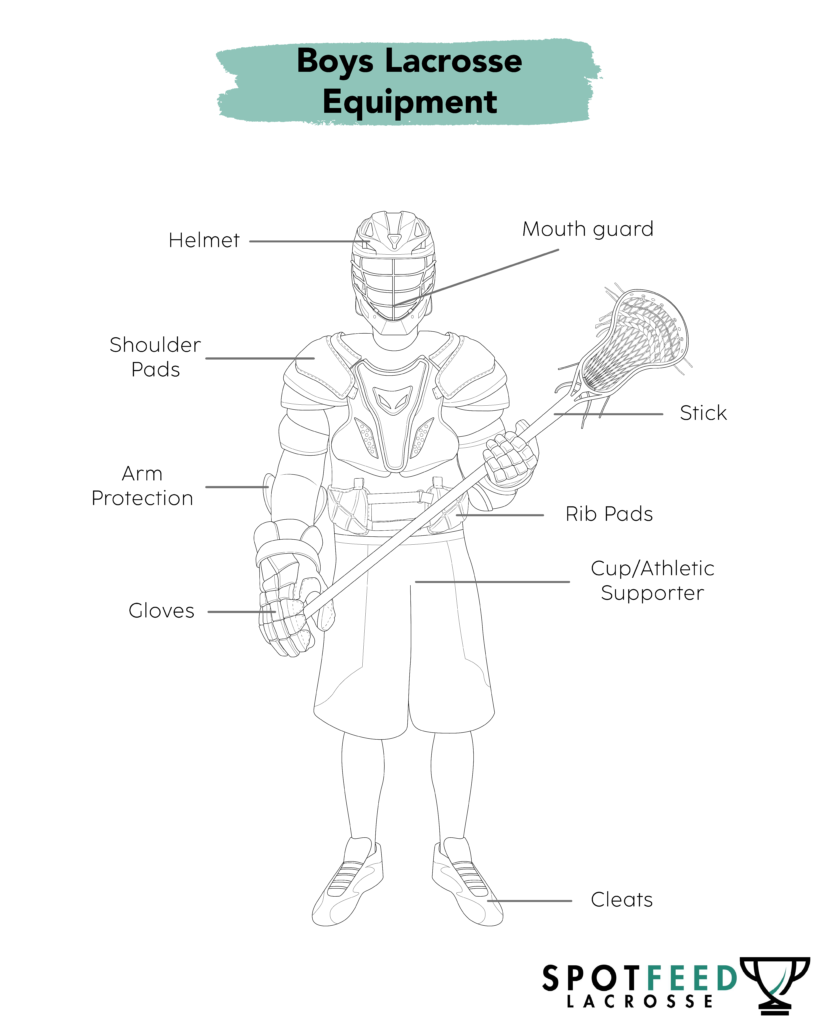
The game field
The action of a lacrosse game happens in a space that’s roughly the size of a football field. An NCAA lacrosse field is 110 yards long and 60 yards wide. For youth and high-school games that may need to share the actual football field, the narrower 53 1/3-yard width is allowed. The two goals sit 80 yards apart, leaving 15 yards of the playable field behind each goal. This area is called the “X.” The goals themselves are at the center of the “crease,” marked by a circle 18 feet in diameter.
One line cuts the lacrosse field in half, and another two cut it roughly in thirds. These are the midfield line and the restraining lines, respectively.
The midfield line separates your team’s half of the field from the other, so that each team has an offensive side and a defensive side. It is also where the face off circle is located. In lacrosse, the face off determines which team is awarded possession of the ball gets after a goal is scored and at the start of each quarter of play.
The restraining lines are 20 yards in each direction from the midfield line and separate each team’s defensive area from the midfield. Depending on your position, you may have to stay in certain areas of the field. The restraining lines tell you where those areas are.
The players
Boys’ lacrosse teams usually have three attackmen (offensive players), three midfielders, three defenders, and one goalie on the field at all times. The three attackers, three defenders, and goalie usually stay behind the restraining lines while the midfielders run both ends of the field.
This means that each time a team gains possession of the ball and carries it into their offensive half of the field, the action turns into a 6v6 player showdown: (3 attackers and 3 midfielders versus 3 defenders and 3 midfielders).
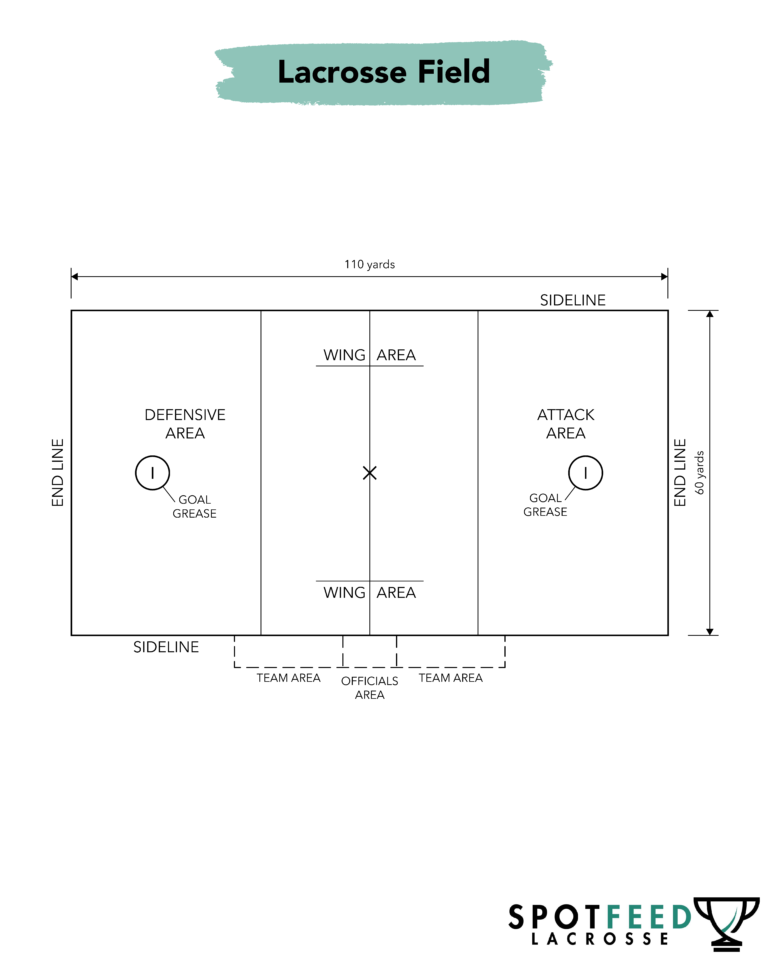
Fouls and Penalties
Fouls are violations of lacrosse rules. Penalties are punishments for players who break these rules. Specific lacrosse rules apply for youth, HS, college, and pro players. But many of the basic lacrosse rules are the same for each.
Personal fouls
Personal fouls include illegal body contact such as a trip, slash, charge, or illegal body check.
Slashing: a slash is an illegal stick check to the body of an opponent. Slashing usually is called for stick checks against players who don’t have the ball or on a part of the body that is not close to the ball (below the waist or above the shoulders).
Charging: a charge is when you lower your shoulder and run directly into a stationary defensive player.
Warding: a ward is when a player with the ball uses his free hand/arm to push or hold an opposing player.
Cross checking: It is legal to hit an opponent with your stick while holding it horizontally, as long as your hands on the stick are close together. If you hit an opponent in this way but with your hands spread too far apart, it is deemed to be a “cross check.” When a player commits a cross check, it counts as a personal foul.
Body checking: the body check–hitting a player with your shoulder–is allowed at the older levels of boys lacrosse but is not permitted at the youth levels of 12-U.
At all levels of lacrosse above 12-U, the basic criteria for illegal body checking are pretty much the same. An illegal body check in lacrosse is defined as a body check that meets any of the following criteria:
Hitting a player above the shoulders
Hitting a player below the waist
Hitting a player from behind (“in the numbers,” as it’s sometimes referred to)
Hitting a player more than five yards away from the ball
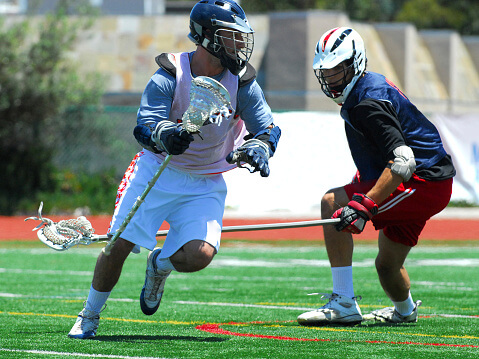
Technical fouls
Technical fouls in lacrosse are deemed less severe than personal fouls. They relate to things like pushing, holding, and procedural violations like the following:
Offsides
Offsides in lacrosse refers to a team that has more than 6 players (excluding goalie) in either half of the field. For this reason, it is important for players in the substitution box to be mindful of where they enter onto the field. If one team commits an offsides violation while they possess the ball, they will lose possession. If a team commits an offsides violation while the other team possesses the ball, this counts instead as a 30-second offsides penalty, giving the other team a man-up opportunity.
Stick penalty
Lacrosse officials will randomly check players’ lacrosse sticks throughout the game to make sure they adhere to proper stick rules regarding length, pocket depth, and other factors. If a stick is found to violate any of these rules, that player will serve a 2-minute non-releasable penalty in the penalty area. Once his penalty is served, he then must fix his stick or use another one that is legal.
Illegal procedure
There are various violations in lacrosse that fall under the general category of “illegal procedure.” These include:
- Touching the ball with a hand: Only goalies can touch the ball by hand and only when they’re in the crease–usually to make saves off their gloves. Players on the field cannot touch the ball by hand.
- Violations on ball clears: Once a team’s goalie has made a save and possesses the ball, he has 4 seconds to pass it to a teammate before he must leave his crease. A goalie can leave the crease with the ball at any time, but once he does he cannot return to the crease with the ball. Also, once the ball leaves the crease, the ball carrier must cross the midfield line within 20 seconds, at which point they then have 10 seconds to cross the restraining line into their offensive end of the field. Failure to comply with any of these time limits on a clear is a technical foul.
- Player leaving penalty area early: It is a technical foul if a player serving a penalty leaves the penalty area before the time on his penalty expires.
- Delay of game: Any actions by a player or coach that cause the game to be delayed will result in a technical foul.
- Crease violations: Only defensive players can enter the crease. It is considered a “crease violation” for offensive players to do so, which results in a turnover of possession to the other team.
Expulsions
In a rare occurrence, there are expulsions that result in a player being permanently removed from a game for an extreme or severe penalty with overly aggressive play or using verbally abusive language. Officials use discretion when deciding to remove a player. Expulsions are 3-minute penalties where the offending team plays a man down in their defensive zone. Another teammate can replace the player once the time has been served.
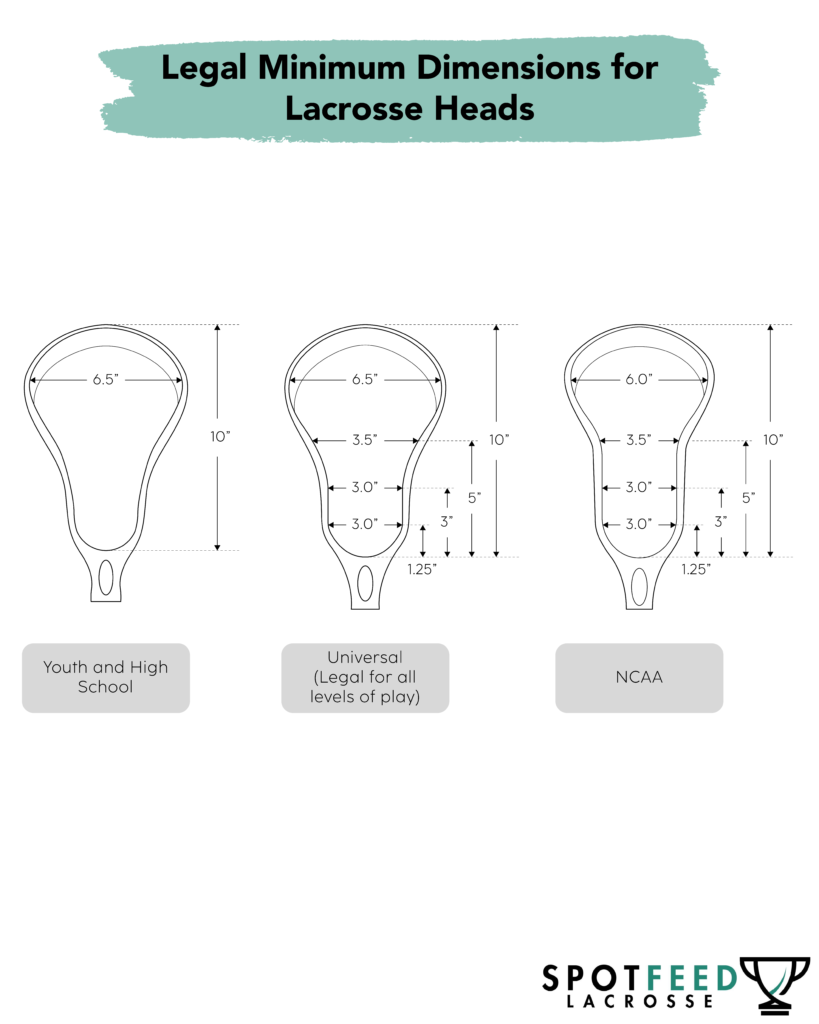
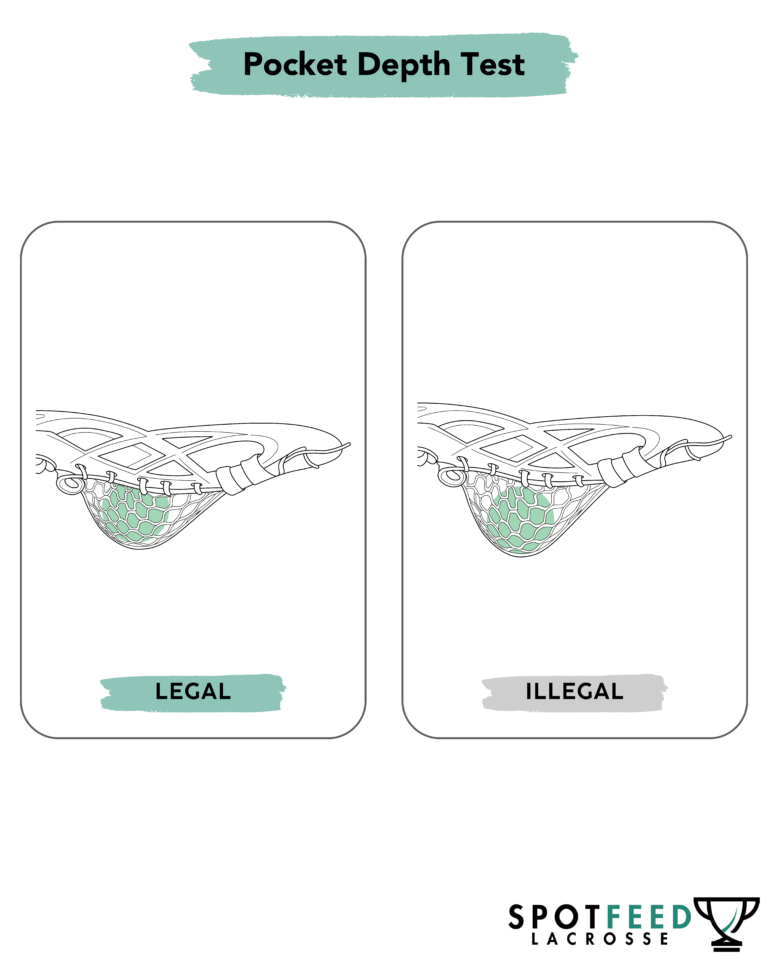
What Happens When a Penalty is Called?
Officials will throw a yellow flag to signal a foul has occurred. Play will usually continue as long as the team that was fouled has possession of the ball. This is so that the victimized team is not robbed of finishing off a potential scoring opportunity. Once possession changes to the team that committed the foul, the whistle blows to stop play so that the official can formally assign the penalty.
Penalty box
Personal fouls usually range in 1-3 minutes depending on the offense. Technical fouls usually last 30 seconds. When a player commits a foul, they serve their penalty time in the penalty box/substitution box which is located in between the teams’ benches near midfield.
Man up/man down
When a player has to serve time in the penalty box, that team cannot substitute another player for him until his penalty expires. This means that his team will have to play “man down,” with one less player on the field than the other team, which is therefore said to be “man up.”
Releasable vs. nonreleasable penalties
Releasable penalties allow the player who fouled to return once the opposing team scores. Non-releasable penalties must be served in their entirety before a player can return, regardless of whether a goal is scored. This means that a team can score multiple goals during a single man-up opportunity. Non-releasable fouls are generally from players using unnecessary roughness or making contact with the head and neck area.
Other Lacrosse Rules
Out of bounds
Play is stopped if the ball goes out of bounds. The team gains possession of the ball as long as they did not throw/touch it before it goes out of bounds. Usually, the player closest to the ball will throw it back in. Off a shot, possession is given to the player closest to the ball when it goes out of bounds.
Can you kick the ball in lacrosse?
Yes, you can kick the ball in lacrosse. Players generally kick the ball to gain possession during a loose ball. Since it’s harder to pick up the ball while “in traffic” (i.e., with lots of other players around), kicking the ball to a teammate that’s nearby or kicking it “to space” where you can scoop it freely are effective strategies to gain possession of the ball. You can even legally score by kicking the ball into the other team’s goal.
FAQs
The basic rules of lacrosse state that two teams of ten players (including a goalie) carry sticks to catch, throw and shoot a ball at a goal. The ball must cross the goal line to count as a goal, which counts as one point for the scorer’s team. The team with the greatest number of points at the end of time wins.
As with most sports, lacrosse comes with its own set of rules and regulations governing what is not allowed, along with particular penalties for violating these rules. While there is a lot of permissible physical contact in lacrosse, fighting is not allowed
As many as you want! Unlike some other sports like basketball, for instance, there are no rules regarding how many steps a player can take, whether he is carrying the ball or not.
The 3-second rule in lacrosse only applies to women’s lacrosse. Essentially, it means that if a player handling the ball is being closely guarded by a defender, she has 3 seconds to make a move with it: pass, dodge, or shoot. Otherwise, possession is awarded to the defending team. The 3-second rule helps to balance out the women’s game, giving defenders an advantage to compensate for the fact that they are not allowed to defend with physical contact in the way that players in men’s lacrosse are.
